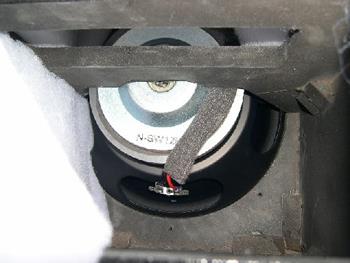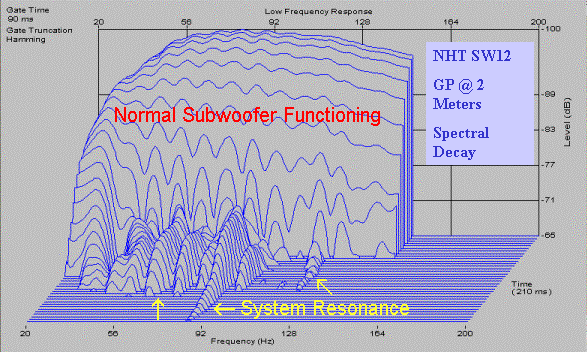
Introduction
NHT was founded in 1986 with the notion that great sound reproduction
doesn't have to break the budget. Someone recently mentioned to me that “NHT has
religion”, and after hearing its hyper sophisticated Xd DSP speaker system
at CES 2005, I couldn't agree more.
The new SW12 powered subwoofer visually complements the NHT Super Audio
loudspeaker lineup, and is designed to offer good performance in mid size
rooms. Its smaller brother the SW10ii is suitable for smaller rooms.
The Design
The SW12 is a bass reflex design, with a front-firing 12” driver, a single
front-firing port (3” inner diameter, 4” flare), and a 24 Hz enclosure
tuning frequency. The driver features a butyl rubber surround, an
aluminum cone, a stamped steel basket, and a large magnet structure.
The NHT design studio should get an award because the SW12 is flat out
gorgeous. The black piano gloss finish is perfect, and with the black anodized
woofer cone, it looks equally good with the grille removed.
The cabinet design is an interesting example of subtle non-symmetry. On the
front face, the top and bottom edges are rounded, and the side edges are
square. Conversely, on the rear face, the top and bottom edges are square,
and the side edges are rounded. This makes for a very modern and pleasing
cabinet geometry when viewed from any angle. Even the injection molded
plastic grille is stylish, with rounded top and bottom contours to match the
cabinet face, and a cool aluminum NHT logo at the bottom.
The interior of the cabinet is lined with Polyfill, and is well
braced. The woofer wiring leads are wrapped in foam, and the heavy amp is
encased in ABS plastic and secured to the cabinet with 12 Allen head screws.
I was very impressed with the quality of construction and attention to
detail.
 There are no permanent feet on the bottom of the cabinet, which is fine for
carpeted surfaces. NHT supplies four flexible rubber stick-on feet for
placing the subwoofer on smooth, hard surfaces. Don't attempt to slide the
subwoofer around after the feet have been mounted, or they will peel off.
There are no permanent feet on the bottom of the cabinet, which is fine for
carpeted surfaces. NHT supplies four flexible rubber stick-on feet for
placing the subwoofer on smooth, hard surfaces. Don't attempt to slide the
subwoofer around after the feet have been mounted, or they will peel off.
The Owner's Manual is quite comprehensive, with detailed descriptions of all
features, a lot of diagrams, and great set-up and fine-tuning advice.
Amplifier Description
- Class G 250 watts continuous.
- On/Off Main Power Switch
- On/Auto (slider switch)
- High Level Screw Post L/R Input Block
- Low Level L/R RCA Filtered Inputs
- Low Level RCA Unfiltered Input
- Low Level RCA Unfiltered Output
- Low Pass Filter (40 Hz - 140 Hz, 2nd order)
- High Pass Filter (23 Hz, 2nd order)
- Gain/Volume
- Phase Control (0/180 slider switch)
- Boundary EQ Switch (3-way slider switch)
- Adjustable Line Voltage (115/230)
- Detachable Power Cord
The control layout is logical, and the slider switches and rotary knobs have
a quality feel and smooth operation. The high level input block only has
screw-down binding posts, rather than the more typical five-way binding post.
The auto-on circuit initializes easily at low volumes. If no signal
is present, there is a 20 minute delay before the amp shuts back off.
 The boundary EQ features consists of a three way slider switch with –3 dB, 0
dB, and +3 dB settings. This allows the user to optimize the subwoofer
frequency response depending on location. NHT recommends the –3 dB setting
for corner loading, the 0 dB setting for mid-wall loading, and the +3 dB
setting if the subwoofer is placed farther away from any walls.
The boundary EQ features consists of a three way slider switch with –3 dB, 0
dB, and +3 dB settings. This allows the user to optimize the subwoofer
frequency response depending on location. NHT recommends the –3 dB setting
for corner loading, the 0 dB setting for mid-wall loading, and the +3 dB
setting if the subwoofer is placed farther away from any walls.
On the Bench
Set-Up: All objective tests were conducted outside away from any reflective
structures, with the microphone on the ground, facing the subwoofer, at a
distance of 2 meters from the width and depth center point. I used the low
level unfiltered input (which bypasses the low pass filter), and set the
phase control to 00 (this resulted in a non-inverted impulse
response).
Frequency Response: An short-duration (about 0.5 seconds), digitally
synthesized logarithmic sine sweep was used to evaluate the quasi-anechoic
frequency response of the subwoofer. The SW12 frequency response measured
27 Hz - 130 Hz ± 3 dB.
Peak Dynamic Output: This test measures how loud the subwoofer can play
across its pass band with a short-duration signal representative of typical
music and movie transients. Short duration frequency response sweeps were
conducted at progressively louder (2 dB increments) levels until dynamic
compression was noted.
In the graph shown below, the yellow curve represents the maximum uncompressed dynamic output of the
SW12, with 106 dB at 90 Hz, and 103 dB at 30 Hz. The next higher curve
(orange) showed dynamic compression in the 30 Hz -80 Hz bandwidth, and the test
was subsequently terminated.

Power Compression: This test measures how loud the
subwoofer can play across its pass band with a longer duration signal. A
sustained bass passage in an action movie can create excessive heat in the
voice coil, reducing longer term output capability. Power compression was
evaluated with a slow reverse sine sweep from 100 Hz down to 10 Hz. Sweeps were
conducted at progressively louder (2 dB increments) levels until power
compression was observed.
As shown in the graph below, the SW12 held steady up to
the orange curve,
with 105 dB at 90 Hz and 102 dB at 30 Hz. The next higher curve (blue)
showed 1 dB of power compression at 30 Hz, but otherwise looked linear.
The next higher curve (green) showed more severe power compression, and the
test was subsequently terminated.
The fact that the power compression levels almost matched the dynamic output
limits indicates the woofer has good thermal power handling and heat
dissipation characteristics.

Total Harmonic Distortion (THD): Harmonic distortion occurs when multiples
of the fundamental signal are produced due to non-linear driver behavior. A
subwoofer with low THD will sound clean and distinct, especially at the
deepest frequencies. THD was evaluated with sine waves (about 5 seconds
duration), and was limited to approximately 10% unless otherwise noted.
Clean output from the SW12 was better than average in the important 20-40 Hz
bandwidth, and very impressive from 50-80 Hz.
| Frequency (Hz) |
SPL (dB) |
THD (%) |
| 20 |
79.1 |
10.1 |
| 22 |
84.9 |
10.4 |
| 25 |
89.0 |
10.1 |
| 32 |
100.6 |
9.8 |
| 40 |
101.3 |
10.7 |
| 50 |
107.5 |
10.4 |
| 63 |
108.1 |
10.6 |
| 80 |
108.7 |
10.3 |
Bandwidth Linearity: Bandwidth linearity is
calculated by dividing the average distortion-limited SPL by the maximum
distortion-limited SPL, and expressing the result as a percentage. A score
of 100% means the subwoofer exhibits perfect clean output linearity across a
given bandwidth. The SW12 performed very well, scoring 90% or better for all
test bandwidths.
| Bandwidth (Hz) |
Average SPL (dB) |
Bandwidth Linearity |
| 20-80 |
97.4 |
90% |
| 22-80 |
100.0 |
92% |
| 25-80 |
102.5 |
94% |
Phase Response and Group Delay: A sufficiently large and abrupt phase shift
may cause the perception of time smearing at the affected frequencies. Group
delay is used to quantify this phenomenon, and was calculated at select
music note frequencies. The approximate audibility thresholds are based on
extrapolations of existing group delay audibility studies.
Group delay from the SW12 remained below the approximate audibility
thresholds at each tested frequency.
| Musical Note/Frequency |
Group Delay (ms) |
Approximate
Audibility
Threshold (ms) |
| F2 / 87 Hz |
2.9 |
15 |
| G1 / 49 Hz |
8.1 |
25 |
| C1 / 33 Hz |
25.6 |
35 |
| A0 / 27 Hz |
40.5 |
42 |
Impulse Response: A phase switch setting of 00 on the SW12 resulted
in a non-inverted impulse response. The impulse response (black line) shows
transient overshoot and system ringing for about 40 ms. This is a normal
performance for a bass reflex subwoofer.

Spectral Decay: Spectral decay was evaluated to the –35 dB level, relative
to the test volume. Several minor system resonances were noted in the 25 Hz - 120
Hz bandwidth. None of the resonances exceeded –25 dB in amplitude, and they
all dropped below the test floor after about 210 ms. This is a typical
performance for a subwoofer, and these resonances won't be audible under
normal use.

In-Room Frequency Response:
The SW12 was placed near the front left corner of my 2,000 ft3 room. For
digital bass management, the main speakers were set to “Small” with a
crossover frequency of 80 Hz. The digital bass management circuit imposes a
2nd order high-pass filter on the speakers, and a 4th order low pass filter
on the subwoofer.
The in-room frequency response was measured at the primary listening
position (about 11 feet from the subwoofer) with the main speakers and the
subwoofer operating. Setting the subwoofer phase to 00 provided the
best results, with no obvious cancellation at the crossover frequency.
The in-room frequency response showed a pronounced peak in the 50 Hz - 75 Hz
region. This peak is the combined result of room acoustics and the
asymmetrical filters in the digital bass management circuit. I used my Rane
PE-17 parametric equalizer (PEQ) to eliminate this mid-bass peak. As expected,
room gain helped to improve deep extension, with the SW12 holding flat to
about 22 Hz, and then sharply dropping 10 dB by 20 Hz.
I experimented with the boundary EQ switch on the SW12. This feature starts
to affect the frequency response below 60 Hz, reaching full effectiveness in
the 30 Hz - 40 Hz bandwidth. I settled on the 0 dB setting, and the final in-room
frequency response was 22 Hz - 100 Hz ±
3 dB (purple line).


With Movies
I played several action-oriented DVDs, evaluating the SW12 for dynamic
impact, sustained output capability, audible artifacts (muddiness,
compression, port chuffing, cone cry, rattling), and deep extension. My
overall subjective home theater ratings for the SW12 are provided in the
table below:
| Evaluation Criteria |
Rating (1-5) |
| Dynamic Impact |
3.50 |
| Sustained Output |
4.00 |
| Audible Artifacts |
2.00 |
| Deep Extension |
3.75 |
Provided below are my listening notes from
Blade II in DTS-ES 6.1 Discrete.
To give readers an idea of how loud the SW12 can comfortably play in my
mid-size room, I increased the master volume until the subwoofer started to
exhibit audible artifacts on the most demanding passages, and then I backed
off a few dB. I monitored the sound pressure level at the listening position
with a B&K meter set to C-weighted fast. The SPL peaks listed are straight
meter readings, with no correction factors added.
Jared Enters Stairwell, 0:01:15-19, 97-98 dB:
This scene features a quick burst of deep moody bass without much masking
sound in the higher registers. I heard some port chuffing from the SW12 on
this scene.
Blood Donation Room, 0:02:11-55, 93-96 dB:
The SW12 dug down to faithfully reproduce the ultra deep bass note that
menacingly builds before Jared attacks the vampires. Few subwoofers can
effectively convey a sense of dread and foreboding on this scene, and the
SW12 pulled it off nicely.
Motorcycle Crash, 0:07:40, 105-107 dB:
Each bounce of the rear motorcycle tire was deep, distinct, and clean. Only
a subwoofer with low distortion in the lowest octave can move the room from
the ground up on this scene and the SW12 played it convincingly with no
muddy overtones.
Extended Fight Scene, 0:09:38-0:10:42, 106-107 dB
Compared to my reference subwoofer, the body blows lacked some visceral
impact, but otherwise had good definition and depth. The full-auto gunfire
bursts were staccato and distinct.
Door Closes, 24:52:60, 101-102 dB:
I also heard some port chuffing on this scene. Again, if port chuffing
occurs, it is always the most noticeable on passages without much other
masking sound.
House Of Pain, 0:38:14-0:39:00, 109-110 dB:
The SW12 really pounded the room on the techno music sounding deep,
powerful, and clean. It played at nearly 110 dB for over 45 seconds with no
signs of thermal power compression or other distress - very impressive.
With Music
I evaluated the SW12 on several music selections for balance, definition,
pitch, and coherence. This subwoofer sounds very good on all types of
popular music. It lacks the ultra-deep extension required to play 17 Hz
organ music, but otherwise digs sufficiently deep even for the synthesized
bass often present in techno and industrial music. Because it has lower than
average distortion in the lowest octave, it exhibits good definition and
pitch when reproducing bass musical instruments. My overall subjective music
ratings for the SW12 are provided in the table below.
| Evaluation Criteria |
Rating (1-5) |
| Balance |
3.75 |
| Definition |
3.75 |
| Pitch |
3.75 |
| Coherence |
3.50 |
Provided below are some listening notes from a few CDs.
1) Rumours - Fleetwood Mac, Warner Brothers Records 1977, 2001 High
Resolution DVD-A. The electric bass in Dreams had good definition and pitch.
The kick drum in opening of The Chain sounded tight without overhang.
2) Underworld Soundtrack - Lakeshore Records, 2003. Renholder's Now I Know
contains extremely deep (about 23 Hz) synthesized bass. Most subwoofers
ignore bass this deep, but the fundamentals were clearly within reach of the
SW12. If I pushed things too hard, the SW12 started to falter and I could
hear some port noise, but at moderately loud volumes the SW12 definitely
delivers the goods on this demanding music track.
3) Go! – Dexter Gordon, Blue Note (Capitol) Records, 1962, 1999. Few classic
jazz aficionados would disagree this is Gordon's finest album. Then budding
bassist Butch Warren anchors the famous composition "Cheese Cake" with perfect
rhythm and lively bass lines. The SW12 filled in the bottom end nicely,
never sounding heavy and blending well with the mains, preserving the
delicate timbre of the upright bass.
4) Horse Of A Different Color - Big & Rich, Warner Brothers Records, 2004.
Rollin' features a throbbing and aggressive bass guitar track, and the SW12
rocks out well on this track, sounding rich and resonant with good pitch on
the bass lines. At the 2:35 mark, there is a surprising deep synthesized bass
effect, and the SW12 dug down and cleanly hit the fundamental with
authority.
Conclusions
The NHT SW12 is exceedingly stylish and handsome, with excellent construction
and
immaculate fit and finish. The innovative boundary EQ feature will help
users fine tune the low end response for various boundary loading and room
placement options.
This subwoofer has a flat frequency response, legitimate in-room extension
to 22 Hz - 23 Hz, and better than average distortion-limited output, which
definitely has a positive impact on pitch, definition, and clarity in the
lowest octave. These qualities help the SW12 to perform well on both music
and HT applications, with occasional port chuffing at loud playback levels
being my only reservation. At more moderate playback levels, the SW12
impresses across the board and without qualification.
The NHT SW12 definitely makes my recommended list, and anyone shopping for a
sub in the $700 range should give it a hard look.
- Ed Mullen -